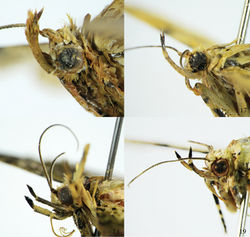Androconia morulusa
| Notice: | This page is derived from the original publication listed below, whose author(s) should always be credited. Further contributors may edit and improve the content of this page and, consequently, need to be credited as well (see page history). Any assessment of factual correctness requires a careful review of the original article as well as of subsequent contributions.
If you are uncertain whether your planned contribution is correct or not, we suggest that you use the associated discussion page instead of editing the page directly. This page should be cited as follows (rationale):
Citation formats to copy and paste
BibTeX: @article{Wang2017ZooKeys, RIS/ Endnote: TY - JOUR Wikipedia/ Citizendium: <ref name="Wang2017ZooKeys">{{Citation See also the citation download page at the journal. |
Ordo: Lepidoptera
Familia: Pyralidae
Genus: Androconia
Name
Androconia morulusa Wang, Chen & Wu sp. n. – Wikispecies link – ZooBank link – Pensoft Profile
Differential diagnosis
The species is similar to An. rallusa Wang, Chen & Wu, sp. n. in external characters. It can be distinguished from the latter by the darker wings. In male genitalia, the juxta of An. morulusa Wang, Chen & Wu, sp. n. is broader than An. rallusa Wang, Chen & Wu, sp. n.
Description
Adult. Forewing length 10.0–11.5 mm (n=3). Male. Head mixed with black and fuscous scales; first and second of labial palpus segments mixed with yellow and fuscous scales; third segment slender, with black scales; antenna with brown scales. Thorax with fuscous or yellow scales. Forewing covered with blackish-green scales; base area yellow, antemedial line indistinct, central area with a rufous androconium present on the discocellular; postmedial line blurry, waved; outer area black; cilia mixed with yellow and black. Hindwing fuscous and more or less reddish. Female. Similar with male, but forewing with less black scales and androconium absent, hindwing redder.
Male genitalia. Uncus slender, densely suffused with setae at lateral apex. Gnathos with slender lateral arms, apex hooked. Valva slender, costa lightly sclerotized; sacculus swollen and warped. Juxta constricted from base to apex, apex bifurcated. Phallus slender, an irregular cornutus present.
Female genitalia. Ovipositor narrow, nearly triangle, covered with dense setae. Apophysis anterioris nearly as same length as apophysis posterioris. Antrum and ductus bursae membranous, slightly longer than corpus bursae. Ductus seminalis relatively broad, then extremely constricted, arising basally from corpus bursae. Corpus bursae nearly elliptic, with two signa, nearly triangle.
Holotype
♂, Guangxi: Maoershan, Gaozhai, 448 m, 13.VIII.2012, Chen Fuqiang, gen. slide. no. Ep691 (IZCAS).
Paratypes
Guangxi: Maoershan, Jiuniutang, 1146 m, 1♀, 19.VIII.2012, Chen Fuqiang, gen. slide. no. Ep690 (IZCAS). Yunnan. Xiaomengyang, 810 m, 1♀, 31.III.1957, Pu Fuji, gen. slide. no. Ep692 (IZCAS).
Distribution
China (Guangxi, Yunnan).
Etymology
The specific name is derived from the Latin “morulus” (= dark-colored) in accordance with the black scales on forewing.
Remarks
The species is sexually dimorphic in color. The male holotype (gen. slide no. Ep691) and a female paratype (gen. slide. no. Ep690) were collected from Maoershan, Guangxi. Although they have different elevations, their localities are adjacent (approximately 3.2 km in straight line). Both of these specimens have the same wing pattern and are thus treated as conspecific.
Original Description
- Wang, M; Chen, F; Zhu, C; Wu, C; 2017: Two new genera and three new species of Epipaschiinae Meyrick from China (Lepidoptera, Pyralidae) ZooKeys, (722): 95-107. doi
Images
|



